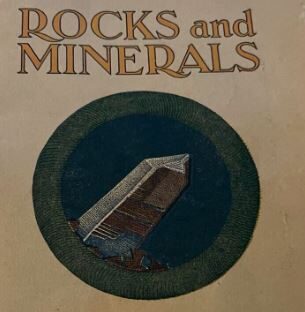Petroleum geologists helped create the Boy Scouts of America geology merit badge in 1953.
The Boy Scouts of America’s geology merit badge began in 1911 as a mining badge — one of less than 30 scouting badges. The mining merit badge in 1937 changed to rocks and minerals before becoming the geology badge in 1953.
The story behind the geology merit badge is best told by a member of the Houston Geological Society (HGS), a resource for potential badge earners.

Petroleum geologists helped inspire the Geology merit badge adopted in 1953.
Petroleum geologist Jeff Spencer, himself an Eagle Scout, has published dozens of petroleum history papers and frequently contributed to Oil-Industry History, the peer-reviewed journal of the Petroleum History Institute (PHI), Oil City, Pennsylvania.
According to Spencer, the original Boy Scouts mining merit badge had several basic requirements, including naming at least 50 minerals; describing the 14 great divisions of the earth’s crust; and defining terms like watershed, delta, drift, fault, glacier, terrace and stratum.
Scouts seeking the mining badge also were asked to identify 10 different kinds of rock and describe methods for mine ventilation and safety devices,

Scouts earned the Rocks & Minerals badge from 1937 until 1953.
The first mention of oil and natural gas appeared in 1927 — the mining badge requirement asked Scouts to “explain how we locate petroleum and natural gas pools, and how we obtain oil and gas,” Spencer notes.
In September 1937, the mining merit badge (a shovel) was replaced with the rocks and minerals badge (a crystal). The first merit badge booklet was published the same year by Daniel O ’Connell, chairman of the department of geology at the City College of New York.
O’Connell’s “Rocks and Minerals” booklet would go through through many revised printings in the next ten years, according to the Geological Society of America (GSA).

The first 12 merit badges of the Boy Scouts of America, which encourages visits to science museums and geology departments of local universities.
In 2014, thanks in part to the Society for Mining and Metallurgy (SME), the mining merit badge returned as “Mining and Society.”
Petroleum Geologists
In 1945, the American Association of Petroleum Geologists (AAPG) formed a “Committee on Boy Scout Literature” at the urging of industry leaders, including A.C. Bace, a geologist with Stanolind, and George W. Pirtlem, an independent geologist from Tyler, Texas.
Oklahoma geologist Frank Gouin chaired the AAPG committee’s effort to revise the merit badge and its requirements, and the geology badge officially replaced the Rocks and Minerals badge in 1953.
Spencer notes that the 1953 merit badge’s description of what a geologist does said that four out of five geologists become “oil geologists” with an expected starting salary of $300 per month.
“You may have to be a nomad instead of settling down for life in one spot,” the description continued. “You may have to ‘sit on’ a well all night and then drive a hundred miles to report on it. You may have to burn in India, freeze in Alaska, or do both in the Texas Panhandle.”
Although minor revisions of the geology merit badge occurred in 1957, the next major change came in 1982, adding anticlines, synclines, and faults with a requirement to draw simple diagrams showing unconformity, strikes and dips.
The last major revision of the geology badge occurred in 1985, Spencer says, again with the cooperation of AAPG leadership. The badge now has 13 requirements, organized under five categories: earth materials, earth processes, earth history, geology and people, and careers in geology.
- The earth materials section includes the collection and identification of rocks and minerals.
- The earth processes section covers geomorphology, the hydrologic cycle, volcanoes, mountain building, and the ocean floor.
- The earth history section includes the geologic time chart, fossils, and continental drift. The geology and people section covers environmental geology and energy sources with a field trip option in this category.
In addition to its involvement in merit badges, AAPG and its chapters serve the scouting program in many ways, Spencer concludes. The Houston Geological Society has sponsored “Explorer Posts” and worked with the Houston Museum of Natural Science to teach the elements of earning the badge.

OPEC-inspired energy badge.
There now are more than 120 merit badges. The OPEC oil embargo of 1973 — and the need for energy conservation — led to creation of an energy merit badge in 1977.
In 2013, Jeff Spencer published a selection of oil patch post cards via Arcadia Publishing’s postcard history series. Texas Oil and Gas includes more than 200 vintage black-and-white images through decades of oil booms throughout the state.
Chapters reflect the Lone Star State’s petroleum heritage by region, including “Spindletop and the Golden Triangle,” a prolific area in southeast Texas between Beaumont, Port Arthur and Orange (read more about Spencer’s Texas oil postcards).
_______________________
Recommended Reading: Texas Oil and Gas, Postcard History (2013); Trek of the Oil Finders: A History of Exploration for Petroleum (1975); Anomalies: Pioneering Women in Petroleum Geology 1917-2017 (2017). Your Amazon purchase benefits the American Oil & Gas Historical Society. As an Amazon Associate, AOGHS earns a commission from qualifying purchases.
_______________________
The American Oil & Gas Historical Society (AOGHS) preserves U.S. petroleum history. Please become an AOGHS annual supporter and help maintain this energy education website and expand historical research. For more information, contact bawells@aoghs.org. Copyright © 2024 Bruce A. Wells. All rights reserved.
Citation Information: Article Title – “Merit Badge for Geology.” Authors: Aoghs.org Editors. Website Name: American Oil & Gas Historical Society. URL: https://aoghs.org/energy-education-resources/geology-merit-badge. Last Updated: May 1, 2024. Original Published Date: June 1, 2008.


